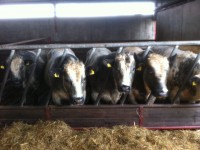We have all heard about acidosis in beef and dairy cows and the negative effects it can have on animal health.
The negative effects of acidosis are reduced intake, problems with feet, reduced milk yields/ milk solids and lower weight gain in beef cattle.
These are some serious problems so what can we do to prevent it?
Firstly lets ask some questions about Acidosis.
Why does Acidosis occur?
Acidosis occurs as a condition when the Acid level of a ruminant animal drops from PH 6 to PH 5 or under. Because cows depend on microbes in the rumen to break down their food we must maintain an acceptable PH level in the Rumen to allow these bugs to flourish. When the PH level drops below optimim PH 6 these bugs are under pressure to survive and cannot function.
When does Acidosis occur?
Acidosis generally occurs when Animals are trying to digest diets with a lack of structural fibre, wet/acidic silages, high cereal diets and suprisingly for many farmers lush grazing. such as found in the early April and May. Indeed a nutritionist told me an interesting story that in one part of the country there is a very old folk tale that in springtime the “Butter Witch” could curse your milk and it would not churn to make butter. They did not have milk solid readings hundreds of years ago but its a fair bet that The Butter Witch was caused by Acidosis and reduced milk solids in cows left out on lush green pasture in Spring! If only Crecora Mills were in business a couple of hundred years ago to banish the Butter Witch!
How do we prevent Acidosis?
Here at John O’Connell feeds we formulate our feeds with a high level of digestible fibre which helps to stabilise the rumen.
We formulate our feeds we are concious of potential Acidosis problems so we keep the acidity levels down on our feeds even though this may make them more expensive for us to produce.
We can include a special additional high performance mineral buffer agent and active yeast which helps to keep the PH of the rumen at an optimum level.
We provide advice to those customers that feed special high cereal diets to their animals and can add a buffer agent and yeast as standard to their feeds or as an alternative if problems arise.
The key points about acidosis is that it can be managed with ease through watching the animals diet. Points to look out for are:
Hoof problems, reduced intake, reduced milk yields and reduced butterfat levels. If you encounter these problems get in touch with us and we can recomend a plan and feed to minimise and overcome them.

